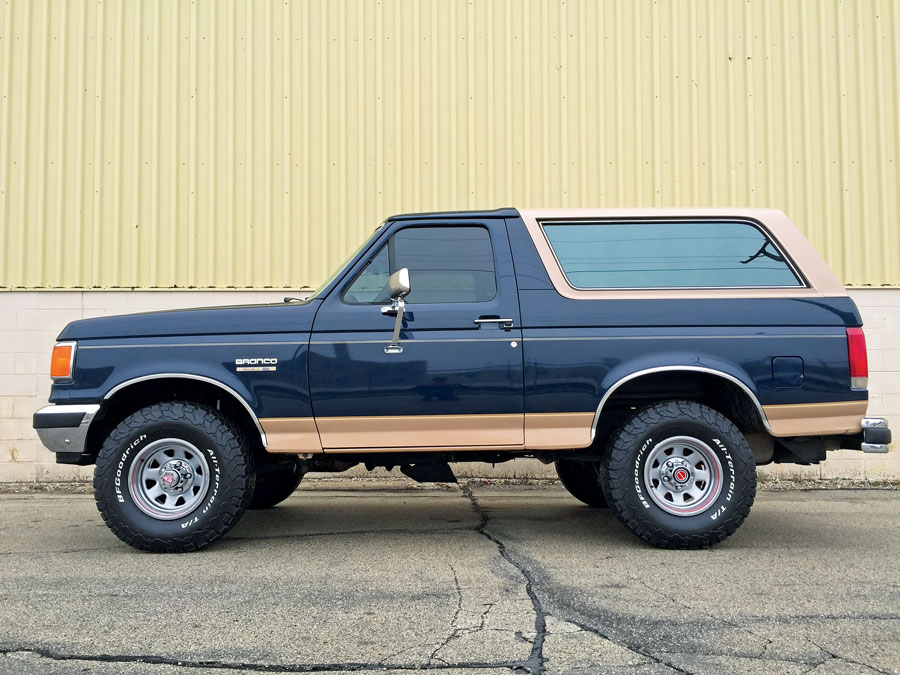
All of us are guilty of it. We buy an old car or truck but secretly wish it didn’t perform like one. It is like adopting a stray pit bull and hoping it won’t bite your toddler, or drinking a case of beer and thinking you won’t have a hangover. But the truth is that vehicles of a certain age just aren’t ideal for today’s roads — or sometimes even today’s owners.
Take, for example, vintage trucks and SUVs. I’m a huge fan, and I’ve had them since long before they were socially acceptable. I’ve driven my ’73 Bronco for years, often as a daily driver, with manual drum brakes, manual steering, 3-speed, and (oh the horror!) even a points-triggered ignition system. It is a great truck and I love the damn thing, but I also realize its limitations. You have to plan your moves somewhat carefully and always make sure you’re driving it — as opposed to it driving you. I’ve experienced, firsthand, how little fun a high-speed “tank slapper” is in an early Bronco on a snow-covered road.
So when my wife wanted an early Bronco of her own, using my experience with these things over the past three decades, I zeroed in on 1977 models. Why? As the last year of the body style, they are the most evolved. Most importantly, the front suspension has more (meaning: some) caster, lending a lot more (okay, some) directional stability. They also have front disc brakes, quicker steering, anti-sway bars, electronic ignition and other running changes that really make them much more user-friendly right out of the box. I found a bone-stock one with an automatic transmission, power steering and power brakes. It drives more like a 1977 than a 1966 and I feel a lot better about her using it as a result.
Make it better?
But as great as the ’77 is, when we started hauling kids in it, other “old car” things became evident. Like razor-sharp exposed metal edges on seat frames and interior panels. The lack of shoulder belts. Or side-impact protection. Or…well, you get the point.
Which brings us to the cottage industry that specializes in modifying vintage vehicles, such as these Broncos, into modernized-but-still-vintage-looking vehicles. Everything from EFI to four-wheel disc brakes to super-plush interiors with a/c and heated seats seems to be standard, as does a hefty price tag. Which makes sense because labor isn’t cheap these days, neither are parts, nor are good “core” vehicles.
And honestly, when all is said and done, isn’t driving a vintage vehicle about experiencing what it would have been like to have one at the point in time it was new? I know it is for me. I like skinny steering wheels, “air conditioning” you open with your feet, and the sense of excitement that comes with skillfully exiting a freeway without rolling over or skidding through the red light at the bottom of the ramp. So that’s the quandary for those of us who like to pile the miles on in our vintage rigs: Do you use a vintage vehicle as-is, knowing it is imperfect and likely unsuited to much of what you use it for, or buy one and spend a fortune trying to make it into something it was never intended to be?
Even a basic build focusing on safety, braking and performance is a costly undertaking, and the results are often underwhelming.
Newer can be smarter
My solution? Consider slightly newer “old” vehicles. In our case we’ll never sell our old Broncos. But we are also not oblivious to the fact that a later-gen Bronco is also a cool vintage truck that’s realistically far better in just about every area.
I hunted down my ideal (newer) old truck — a 1989 Eddie Bauer full-size Bronco, with an EFI 5.8L (that’s a 351W with fuel injection, for us old guys), a C6 automatic trans, manual locking hubs, and a manual-shift transfer case to maintain its true-truck status. But it also has power everything, a/c, a comfortable (and far quieter) interior, and tons of room for the whole family. And the best part? The whole truck cost less than it would have cost to cut up and modify an early Bronco to a similar level.
The icing on the cake is that I think these later SUVs (Broncos, Blazers, Wagoneers, Ramchargers, etc.) in clean, stock condition will continue to increase in value for the very reasons above, not to mention they are just off the bottom of their depreciation curve. With careful shopping, it is shocking how nice of a truck you can find for well under $20k. Of course, that seems to be changing quickly, so don’t say I didn’t warn you.
This same logic can be applied to virtually any vintage vehicle still seeing regular use. Worried about driving your 1967 Chevy K10 pickup on today’s supersonic highways day in and day out? Pick up (pun intended) a 1987 model to drive every day and preserve the old one for more fun missions. Same goes for your favorite old Camaro or Mustang. Deciding there are just some applications they are no longer ideal for doesn’t mean you can’t drive a cool old Camaro or Mustang — just pick one that’s not so old.
Another case in point: I’ve finally decided that throwing my kids in the back of our ’66 Mustang and going 75 mph around countless zombies driving and texting may not be the smartest thing. So I’ve recently picked up a Fox-body 1980s Saleen Mustang … but that’s a story for another time. Needless to say, as somebody who came of age in the 1980s, I’m rather enjoying playing with the cars I lusted for then and forgot all about.
I will now leave you all to scour the Internet with your own 1980s wish list. Be sure to drop me a line and tell me what follows you home!